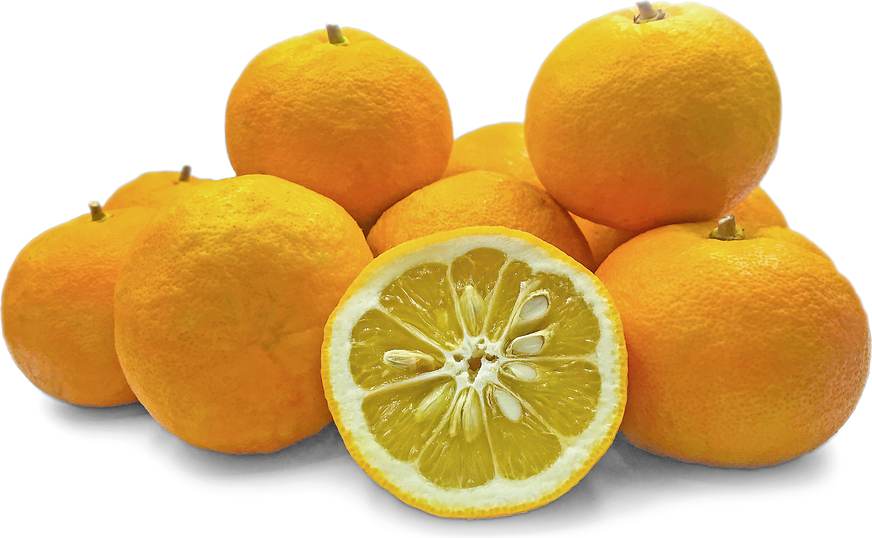


Italian Sour Oranges
Estimated Inventory, lb : 0
Description/Taste
Italian Sour oranges are small, somewhat uniform fruits, averaging 7 to 8 centimeters in diameter, and are round to oval in shape. The skin is rough, firm, and thick, ripening from green to orange when mature, and is covered in many small oil glands creating a bumpy appearance. Underneath the surface, the pale orange flesh is divided into 10 to 12 segments by thin, white membranes and is aqueous with a few to many small, inedible seeds. Italian Sour oranges are highly aromatic and are known for their acidic, sour, and extremely bitter flavor.
Seasons/Availability
Italian Sour oranges are available in the late fall through early spring.
Current Facts
Italian Sour oranges, botanically classified as Citrus aurantium, are bitter fruits that belong to the Rutaceae or citrus family. Sour oranges were introduced to Italy in the 12th century by Portuguese sailors and quickly became a favored tree planted in the urban landscape of Rome. The fragrant trees continued to increase in popularity, expanding into the countryside, where they were cultivated as a specialty variety in orchards and monasteries and are still found growing in the modern-day. There are many different cultivars generally classified as Italian Sour oranges sold in local markets, and the fruits are also known by other names, including Portogalli, Arance Amare, Melangoli, and Bitter oranges. Italian Sour oranges are primarily used for their juice and fragrant rind as a flavoring in both sweet and savory culinary applications.
Nutritional Value
Italian Sour oranges contain some fiber, which can help regulate digestion and provide folate, magnesium, and potassium. The fruits are also a good source of vitamin C, which is an antioxidant that can increase collagen production and boost the immune system.
Applications
Italian Sour oranges are considered unpalatable as a stand-alone fruit and are best suited as a flavoring, paired with other ingredients to balance the bitter taste. The fruits can be pressed into juice for beverages and cocktails or used to flavor soups, stews, dressings, sauces, and dips. The juice can also be used as a marinade for meat and seafood or used as a flavoring for baked goods, desserts, and candies. In addition to the juice, the rinds are popularly used to make marmalade. The rinds contain a high pectin content, which helps solidify the spread, and once prepared, the marmalade can be spread on toast, crackers, and roasted meats. Italian Sour oranges can also be pickled as a condiment or candied as a sweet-tart treat. In Vetralla, Italy, Italian Sour oranges are roasted in an open fire and spread over toast with tomatoes and olive oil as a sweet and savory appetizer. In Sicily, oil is extracted from the peel and is used to flavor ice creams, candies, chewing gum, and gelatins. Italian Sour oranges pair well with meats such as chicken, duck, pork, beef, and fish, seafood, garlic, bay leaves, cumin, serrano peppers, and herbs such as cilantro, oregano, and thyme. The bitter fruits will keep 2-4 weeks when stored loosely wrapped in the crisper drawer of the refrigerator.
Ethnic/Cultural Info
In Italy, neroli oil is one of the most famous scents of the country and is developed from the delicate white blossom of the Italian Sour orange tree. To make the oil, over one thousand blossoms are needed to produce one pound of oil, and the blossoms must be hand-harvested to protect the delicate petals from being crushed. Once the flowers are collected, they are placed in a steam distillation process to extract their essence, creating a honeyed, sweet, and green fragrance. Sour orange blossom oil has been around since ancient times, but the oil became widely produced after Italian princess Anne-Marie de la Tremoille made it her signature fragrance. Legend has it that Tremoille would bath in scented sour orange blossom water and would sprinkle the oil over her gloves to create a lingering aroma. With the princess’s endorsement, the oil quickly increased in popularity and was eventually renamed to neroli in honor of the princess’s homeland of Nerola. In the modern-day, neroli oil is one of the foundational scents used in eau-de-cologne.
Geography/History
Sour oranges are native to southeast Asia and have been cultivated since ancient times. The fruits were first introduced to Italy through trade in the 12th century and were quickly planted in both urban landscapes and countryside orchards across the country. Today Italian Sour oranges are widely grown throughout Italy and are found in local markets, home gardens, and specialty grocers.




